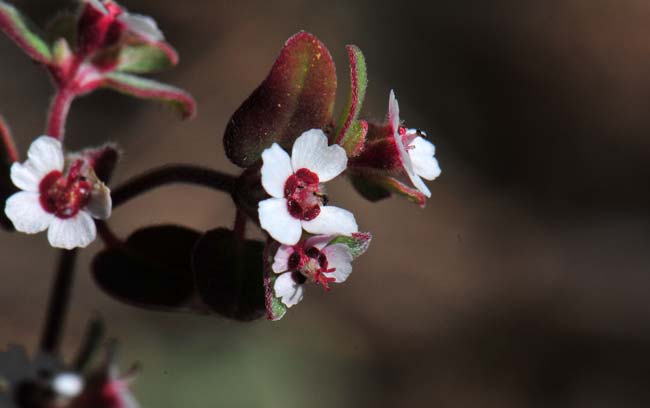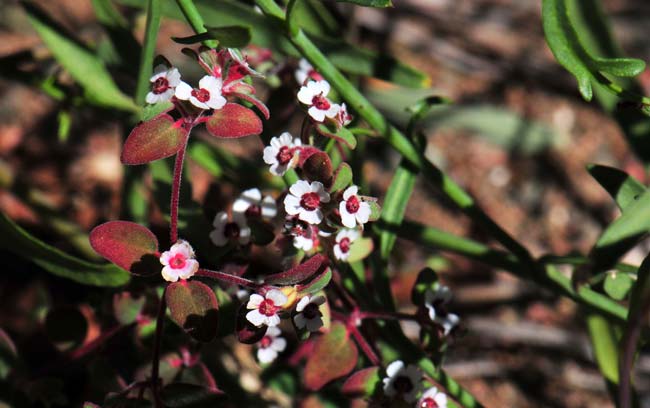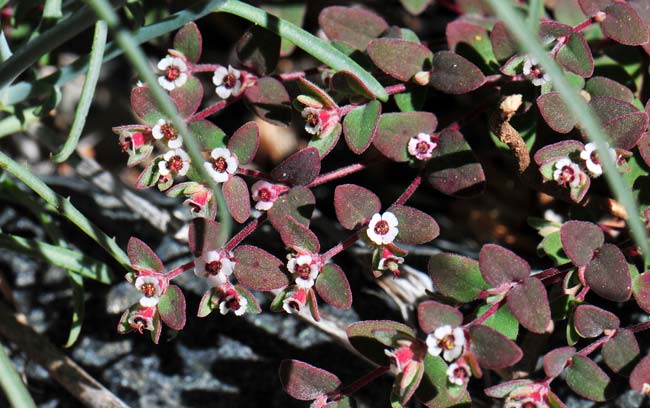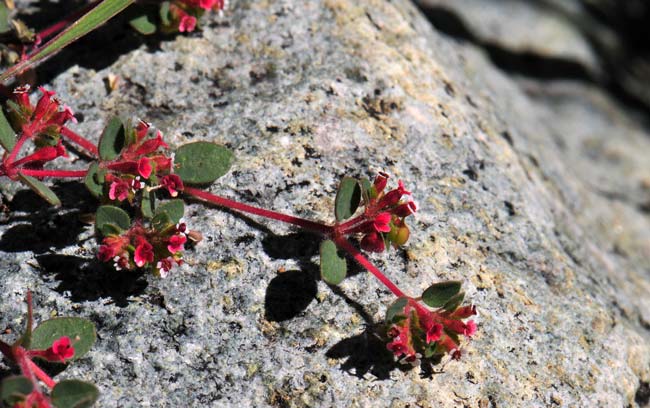Chamaesyce melanadenia, Red-gland Sandmat




Scientific Name: Chamaesyce melanadenia
Common Name: Red-gland Sandmat
Also Called: Squaw Sandmat
Family: Euphorbiaceae, Spurge or Euphorbia Family
Synonyms: (Anisophyllum melanadenium, Chamaesyce melanadenia, Euphorbia cinerascens var. appendiculata, Chamaesyce aureola and Euphorbia polycarpa var. appendiculata)
Status: Native.
Duration: Perennial
Size: Up to 6 inches more or less.
Growth Form: Forb/herb; decumbent or ascending, may be almost prostrate in open flats especially so in disturbed soil, forms small clumps or mats, stems slender, tangling, reddish, tomentose.
Leaves: Green; opposite, simple, pubescence tomentose, shape variable; linear, oval or ovate, acute, leaf small, about 1/3 inch wide.
Flower Color: White; petaloid appendages, appendages scalloped, usually much wider than the subtending nectar glands, glands red, reddish or dark purple, monecious, inflorescence resembles a "flower", "flower" is a cyathium, flowers in clusters, male flowers surround a single female flower, flora involucre small, about 2mm, bell-shaped, tomentose, (see photo above), fruit a glabrous capsule.
Flowering Season: January to December.
Elevation: 500 to 5,000 feet.
Habitat Preferences: Dry rocky hillsides, open flats and disturbed areas often among shrubs; found in both deserts and upland.
Recorded Range: Chamaesyce melanadenia is relatively rare in the United States. It only occurs in Arizona and California, primarily in Arizona where it is found throughout much of the state. Also found throughout Baja California and northern Mexico.
North America & US County Distribution Map for Chamaesyce melanadenia.
U.S. Weed Information: No information available.
Invasive/Noxious Weed Information: No information available.
Wetland Indicator: No information available.
Threatened/Endangered Information: No information available.
Comments: Red-gland Sandmat is not a common sandmat but has a distinguishing identifying feature with red or reddish nectar glands as well as this plants overall reddish color and tomentose pubescence.
In Southwest Desert Flora also see: Chiricahua Mountain Sandmat, Chamaesyce florida, Whitemargin Sandmat, Chamaesyce albomarginata; Arizona Sandmat, Chamaesyce arizonica; Head Sandmat, Chamaesyce capitellata; Royal Sandmat, Chamaesyce dioica; Hyssopleaf Sandmat, Chamaesyce hyssopifolia; Carrizo Mountain Sandmat, Chamaesyce pediculifera; Threadstem Sandmat, Chamaesyce revoluta and Yuma Sandmat, Chamaesyce setiloba.
Red-gland Sandmat has been used as a dermatological aid and as ear medicine. See ethno-botanical uses at Native American Ethnobotany, University of Michigan, Dearborn.

